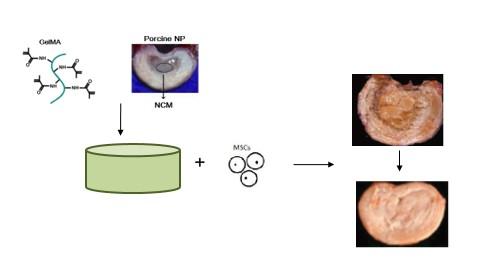
IVD degeneration is characterized by a decreased number of nucleus pulposus cells (NPCs) in the nucleus pulposus and, therefore, by a decrease in nucleus pulposus matrix production. Pulverized notochordal cell-rich nucleus pulposus matrix (NCM), has proven to stimulate NPCs and differentiation of human bone marrow-derived mesenchymal stem cells (MSCs) towards chondrocyte-like cells. In previous research, MSCs were seeded in an NCM hydrogel to implant into a degenerating IVD, but after a two-week culture the cells did not adopt a rounded morphology in the hydrogel which may allow the cells to differentiate towards chondrocyte-like cells. Therefore, a hydrogel consisting of gelMA and NCM seeded with MSCs was created in this study. GelMA ensures a rounded morphology of cells, so it was expected that such hydrogel would ensure a rounded morphology of the MSCs, allowing differentiation towards chondrocyte-like cells. Hydrogels with different ratios of gelMA and NCM seeded with MSCs were cultured for two weeks in standard high-glucose medium iso-tonic to in-situ NP in an incubator. A cell viability test, phalloidin staining and several histological stainings were performed to assess cell viability, cell morphology and content of NP-specific matrix compounds, respectively. The cells in each hydrogel adopted a round morphology and hydrogels containing [8% gelMA, 2% NCM] and [9.5% gelMA, 0.5% NCM] showed most NP-specific matrix compound content around the cells, indicating possible differentiation of MSCs towards chondrocyte-like cells. It can be concluded that a combination of gelMA and NCM in hydrogels does have potential as regenerative IVD therapy, but further research is needed to investigate the exact role of the ratio of gelMA and NCM in the hydrogel.